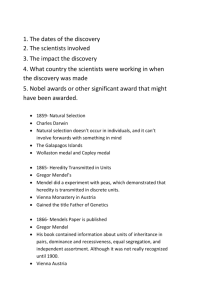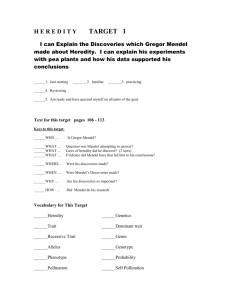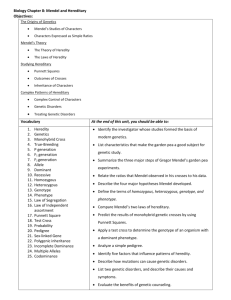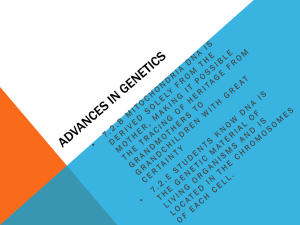Research for DNA Day
advertisement
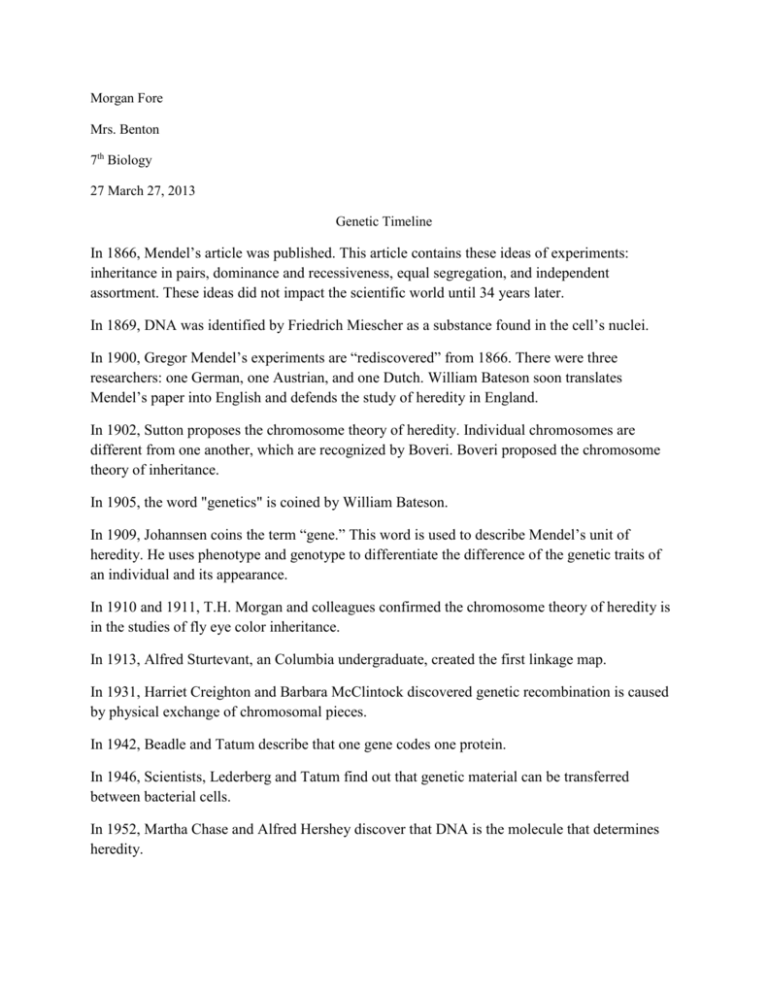
Morgan Fore Mrs. Benton 7th Biology 27 March 27, 2013 Genetic Timeline In 1866, Mendel’s article was published. This article contains these ideas of experiments: inheritance in pairs, dominance and recessiveness, equal segregation, and independent assortment. These ideas did not impact the scientific world until 34 years later. In 1869, DNA was identified by Friedrich Miescher as a substance found in the cell’s nuclei. In 1900, Gregor Mendel’s experiments are “rediscovered” from 1866. There were three researchers: one German, one Austrian, and one Dutch. William Bateson soon translates Mendel’s paper into English and defends the study of heredity in England. In 1902, Sutton proposes the chromosome theory of heredity. Individual chromosomes are different from one another, which are recognized by Boveri. Boveri proposed the chromosome theory of inheritance. In 1905, the word "genetics" is coined by William Bateson. In 1909, Johannsen coins the term “gene.” This word is used to describe Mendel’s unit of heredity. He uses phenotype and genotype to differentiate the difference of the genetic traits of an individual and its appearance. In 1910 and 1911, T.H. Morgan and colleagues confirmed the chromosome theory of heredity is in the studies of fly eye color inheritance. In 1913, Alfred Sturtevant, an Columbia undergraduate, created the first linkage map. In 1931, Harriet Creighton and Barbara McClintock discovered genetic recombination is caused by physical exchange of chromosomal pieces. In 1942, Beadle and Tatum describe that one gene codes one protein. In 1946, Scientists, Lederberg and Tatum find out that genetic material can be transferred between bacterial cells. In 1952, Martha Chase and Alfred Hershey discover that DNA is the molecule that determines heredity. In 1953, Watson and Crick used Rosalind Franklin’s information to find out that DNA is in the shape of a double helix with nonparallel nucleotide chains and specific base pairing. In 1958, Meselson and Stahl find out that DNA replication is semi-conservative by using balanced density gradient radial. In 1961, Brenner, Jacob, and Meselson detect that mRNA takes data from the DNA in the nucleus to the protein coding system in the cytoplasm. In 1966, Nirenberg and other scientists find out that the genetic code determines the orders of the 20 kinds of amino acids in proteins. The impact of this allows the genetic code to acknowledge nucleic acids with the four letter alphabet. In 1975, Sanger and his colleagues, plus Maxam and Gilbert, expand fast DNA sequencing methods. Sanger method impacted us the most because most lab workers use colored dyes to identify each o0f the four nucleic acids that make up DNA. In 1977, Robert and Sharp experiment a lab that shows that eukaryotic genes contain many disturbances called introns. These non-coding areas don’t directly specify the amino acids that make proteins in products. In 1986, Kary Mullis creates the Polymerase Chain Reaction. The PCR impacts the world today because it clones DNA copies. In 1990, Pat Brown and her colleagues invent DNA microarrays. In 1996 and 1997, Ian Wilmut and his colleagues experimented the first cloning of a mammal from the Roslin institute in Scotland. In 2005, Scientists complete the chimp genome and leading comparisons with the human genome to find differences.

